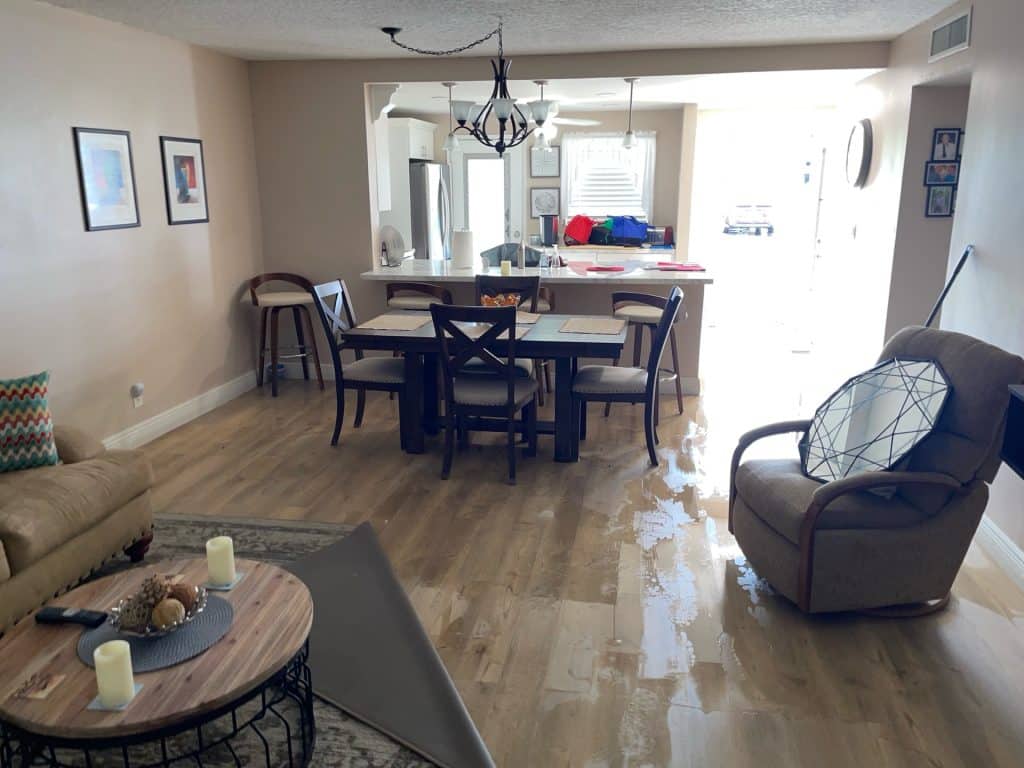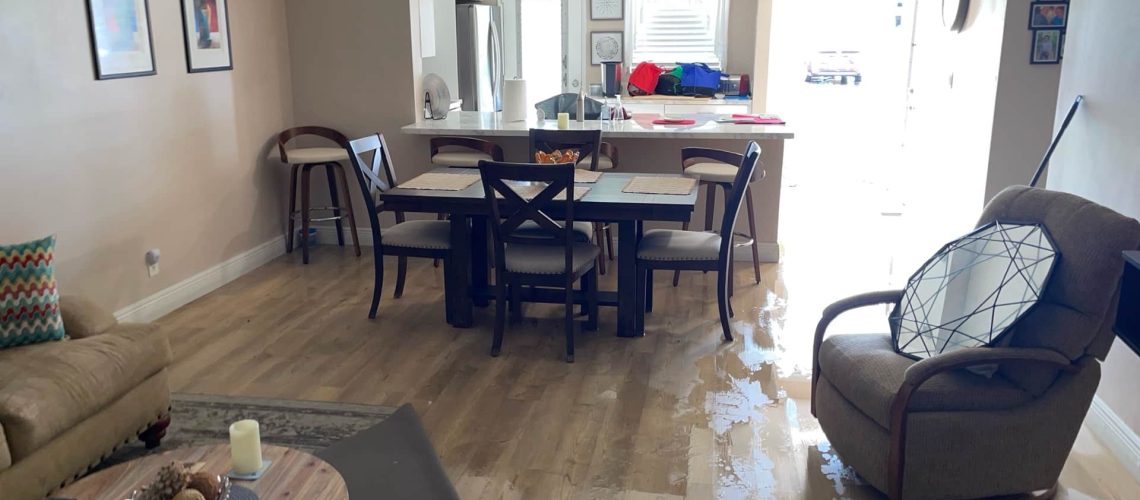From small ceiling stains caused by a slow leak to full-blown floods that take over entire properties, at Cinergy Restoration, we’ve seen water damage of all kinds. One of the most common questions we hear from homeowners and business owners is: “Will water damage go away on its own?”
It’s a fair question. After all, if the surface looks dry after a day or two, it’s tempting to assume that the problem has cleared itself up, but unfortunately, water damage is rarely that simple. What’s visible on the outside is often just the tip of the iceberg.
In this guide, we’re breaking down what happens to water-damaged areas over time, the risks of leaving it untreated, and what you should do instead. Our goal is to help you avoid bigger problems and get back to normal faster and safer.
Key Takeaways
- Water damage does not go away on its own—it often causes hidden structural and health issues if ignored.
- Just because a surface looks dry doesn’t mean it is. Moisture can linger in walls, floors, and insulation.
- Mold can begin to grow in as little as 24 hours, making early intervention critical.
- Delaying action can lead to higher repair costs, compromised structures, electrical hazards, and health concerns.
- Cinergy Restoration uses advanced tools and proven methods to detect, dry, and restore your space completely.
What Happens When Water Damage Is Left Alone?
Water doesn’t just sit quietly and evaporate. It seeps into materials, creates hidden moisture pockets, and provides the perfect conditions for mold, bacteria, and structural deterioration. When water damage is left to “go away on its own,” the situation often gets worse before it gets better, if it gets better at all.
Here’s what can happen beneath the surface:
- Wood swells and rots: Whether it’s floorboards, cabinets, or framing, wood absorbs water quickly. Over time, it can warp, weaken, or begin to rot.
- Drywall softens and crumbles: Even a small water leak behind a wall can compromise your drywall’s structural integrity.
- Mold begins to grow: Mold can start developing in as little as 24 to 48 hours. And it doesn’t take a flood of water to pop up, just moisture and time.
- Insulation becomes soggy and ineffective: Insulation that’s gotten wet often loses its effectiveness and needs to be replaced.
- Electrical components are compromised: Wiring, outlets, and circuit boxes can corrode or short-circuit when exposed to water.
So, can water damage just dry up and go away? Technically, yes, the moisture might evaporate, but the damage it leaves behind won’t disappear. It might even get worse.
“It Looks Dry”—Why That’s Not Always a Good Sign
We get it. You mop up a puddle, set up a fan, and after a few hours or days, everything looks fine. No more wet carpet, no more musty smell. But appearances can be deceiving.
Here’s why:
- Moisture can linger deep inside walls, floors, and subfloors.
- Porous materials (like carpet, wood, and drywall) trap water that can’t be seen or felt from the surface.
- Humidity levels rise in the affected area, which can affect indoor air quality and trigger mold growth even if the room feels dry.
That’s why professional water damage experts like us use moisture meters, thermal imaging, and hygrometers, not just a visual inspection. We don’t just treat what’s on the surface. We track down what’s hiding underneath to make sure the job is truly done.
The Risks of Waiting Too Long
Water damage doesn’t just go away. It changes and evolves, often turning from a minor nuisance into a major issue. The longer you wait, the worse (and more expensive) it can get.
Here are a few risks of ignoring water damage:
Mold Infestation
As mentioned, mold can begin to grow within 24–48 hours. Once it takes hold, it spreads quickly through spores in the air and can cause health issues like coughing, sneezing, headaches, and even respiratory infections.
Structural Damage
What starts as a damp spot in your drywall or flooring can lead to major repairs if the materials begin to rot, sag, or buckle. Over time, your home or building’s structural integrity could be compromised.
Electrical Hazards
Water and electricity don’t mix. Wet wires or outlets could lead to electrical fires or shocks. If water gets into your walls or ceiling, your electrical system could be at risk without you even knowing it.
Decreased Property Value
Water stains, warped floors, musty odors, and mold all decrease the value of your home or commercial property. Even if the issue seems resolved on the surface, future buyers (or their inspectors) will notice.
Higher Repair Costs
Waiting too long often means bigger, more complex restoration jobs. What could have been handled with drying equipment and minor repairs might now require mold remediation, wall or floor replacement, and full restoration services.

Why Professional Help Matters
Trying to handle water damage on your own can feel like a way to save a couple bucks, but it often leads to costlier repairs in the long run. At Cinergy Restoration, we don’t just remove water, we address every layer of the problem to make sure your property is truly safe and sound.
Here’s how we help:
- Thorough inspection: We use advanced moisture detection tools to find hidden water.
- Complete water removal: We don’t stop until all water and moisture are removed.
- Drying and dehumidification: Our industrial-grade equipment ensures your property is properly dried and stabilized.
- Restoration services: From drywall replacement to structural repairs, we restore your space to pre-loss condition.
- Mold prevention: By acting fast and treating every affected surface, we help prevent mold from ever having a chance to grow.
The Cinergy Restoration Approach
At Cinergy Restoration, we specialize in identifying, treating, and restoring properties affected by water damage. We don’t cut corners or guess. We use industry-standard techniques and tools to ensure your property is clean, dry, and safe.
When you choose us, here’s what you can expect:
- Fast response times
- Friendly, experienced technicians
- Detailed moisture tracking
- Honest, clear explanations every step of the way
- Respect for your property and peace of mind
Whether it’s a burst pipe, roof leak, flooded basement, or appliance overflow, we’re here to help—24/7.
What You Should Do If You Suspect Water Damage
If you see, smell, or suspect water damage, it is important to take action right away:
- Stop the source – Shut off water supply if needed.
- Avoid affected areas – Especially if there’s electrical risk, contaminated water, or potential mold.
- Call a professional – Reach out to Cinergy Restoration so we can assess and act quickly.
- Document the damage – Take photos for insurance purposes.
- Don’t wait – The longer you wait, the worse it could get.
Final Thoughts
It’s tempting to hope that a little water damage will dry out and disappear. But as professionals who deal with the consequences every day, we can tell you—that’s a risk you don’t want to take. Left unchecked, even minor water damage can turn into major repairs, health risks, and costly restoration.
At Cinergy Restoration, we’re here to take the guesswork (and stress) out of the equation. Whether you’re dealing with a fresh leak or lingering moisture from a past event, we’re ready to help you assess, act, and restore your space the right way.
Don’t wait for water damage to go away—let us help make it go away for good. Call us now to get started.




